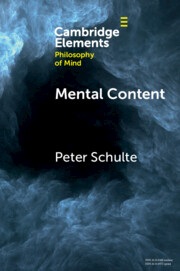Refine search
Actions for selected content:
78 results
Chapter 26 - Intentional Objects in Later Neoplatonism
- from Part V - Metaphysics
-
- Book:
- The Ladder of the Sciences in Late Antique Platonism
- Published online:
- 08 December 2025
- Print publication:
- 08 January 2026, pp 350-359
-
- Chapter
- Export citation
Chapter 16 - Contemplations
- from Part IV - Concrete Operations of One-to-One Correspondence for Equality Matching, Arbitrary Symbolism for Market Pricing, Combinations of Conformations, and What Children Discover
-
- Book:
- Representing Relationships
- Published online:
- 21 November 2025
- Print publication:
- 11 December 2025, pp 348-364
-
- Chapter
- Export citation
Kant, Intentional Laser Beams, and the Mismatch Argument for a Phenomenalist Reading
-
- Journal:
- Kantian Review , First View
- Published online by Cambridge University Press:
- 25 September 2025, pp. 1-21
-
- Article
-
- You have access
- Open access
- HTML
- Export citation
21 - Interaffectivity Disturbances in Narcissistic Personality Disorder
- from Part V - Perspectives on Borderline and Narcissistic Personality
-
-
- Book:
- Conceptualizing Personality Disorder
- Published online:
- 25 June 2025
- Print publication:
- 10 July 2025, pp 373-385
-
- Chapter
- Export citation
24 - How Much Harm Does It Take? An Experimental Study on Legal Expertise, the Severity Effect, and Intentionality Ascriptions
- from Part III - Applications
-
-
- Book:
- The Cambridge Handbook of Experimental Jurisprudence
- Published online:
- 17 May 2025
- Print publication:
- 05 June 2025, pp 399-415
-
- Chapter
- Export citation
7 - Race and the Limits of the Law
-
- Book:
- Race and the Law in the United States
- Published online:
- 19 May 2025
- Print publication:
- 05 June 2025, pp 293-332
-
- Chapter
- Export citation
17 - Automaticity and Implicit Measures
- from Part III - Deep Dives on Methods and Tools for Testing Your Question of Interest
-
-
- Book:
- Handbook of Research Methods in Social and Personality Psychology
- Published online:
- 12 December 2024
- Print publication:
- 19 December 2024, pp 404-426
-
- Chapter
- Export citation
Chapter 5 - Collingwood and Phenomenology
- from Part I - Situating Collingwood: Beyond Idealism
-
-
- Book:
- Interpreting R. G. Collingwood
- Published online:
- 22 November 2024
- Print publication:
- 05 December 2024, pp 82-101
-
- Chapter
- Export citation
The Culprit-Hypothesis: how blame attribution influences the interpretation of expressive adjectives
-
- Journal:
- Language and Cognition / Volume 16 / Issue 4 / December 2024
- Published online by Cambridge University Press:
- 10 October 2024, pp. 2169-2187
-
- Article
-
- You have access
- Open access
- HTML
- Export citation
Cultural evolution as inheritance, not intentions
-
- Article
-
- You have access
- Open access
- HTML
- Export citation
Phenomenological Thomism: A Prooemium
-
- Journal:
- New Blackfriars / Volume 105 / Issue 2 / March 2024
- Published online by Cambridge University Press:
- 04 March 2024, pp. 180-199
- Print publication:
- March 2024
-
- Article
-
- You have access
- Open access
- HTML
- Export citation
37 - Tort Law Decision-Making
- from Part V - Other Legal Decision-Making
-
-
- Book:
- The Cambridge Handbook of Psychology and Legal Decision-Making
- Published online:
- 22 February 2024
- Print publication:
- 29 February 2024, pp 567-581
-
- Chapter
- Export citation
Ending the war on error: towards an archaeology of failure
-
- Article
-
- You have access
- Open access
- HTML
- Export citation
6 - The Regime of Signs
- from Part II - The Incarnation of the Word
-
- Book:
- An Augustinian Christology
- Published online:
- 02 November 2023
- Print publication:
- 16 November 2023, pp 217-247
-
- Chapter
- Export citation
2 - Studying Narrative Politics in Motion
-
- Book:
- The Uncertainty Doctrine
- Published online:
- 31 August 2023
- Print publication:
- 14 September 2023, pp 27-48
-
- Chapter
- Export citation

Mental Content
-
- Published online:
- 12 August 2023
- Print publication:
- 31 August 2023
-
- Element
- Export citation
The Contents of Imagination
-
- Journal:
- Canadian Journal of Philosophy / Volume 52 / Issue 8 / November 2022
- Published online by Cambridge University Press:
- 28 July 2023, pp. 828-842
-
- Article
-
- You have access
- Open access
- HTML
- Export citation
11 - Responsibility
- from Part II - Aspects of Ethical Agency
-
-
- Book:
- The Cambridge Handbook for the Anthropology of Ethics
- Published online:
- 11 May 2023
- Print publication:
- 25 May 2023, pp 281-308
-
- Chapter
- Export citation
37 - Philosophical Issues in Computational Cognitive Sciences
- from Part V - General Discussion
-
-
- Book:
- The Cambridge Handbook of Computational Cognitive Sciences
- Published online:
- 21 April 2023
- Print publication:
- 11 May 2023, pp 1201-1227
-
- Chapter
- Export citation
Chapter 2 - Dynamis (Dynamism, Capacity) and Energeia (Actuality)
- from Part I - Shakespeare and Virtue Ethics
-
-
- Book:
- Shakespeare and Virtue
- Published online:
- 19 January 2023
- Print publication:
- 26 January 2023, pp 28-35
-
- Chapter
- Export citation



